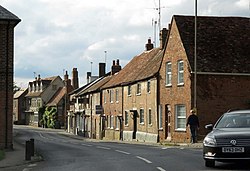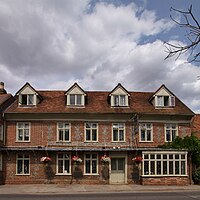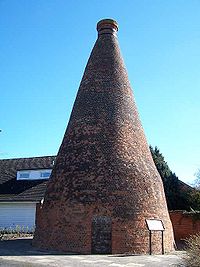Difference between revisions of "Nettlebed"
(Created page with "{{Infobox town |name=Nettlebed |county=Oxfordshire |picture= High Street, Nettlebed - geograph-5294834.jpg |picture caption=High Street, Nettlebed |os grid ref=SU700867 |latit...") |
(No difference)
|
Latest revision as of 20:25, 7 November 2019
| Nettlebed | |
| Oxfordshire | |
|---|---|
 High Street, Nettlebed | |
| Location | |
| Grid reference: | SU700867 |
| Location: | 51°34’32"N, 0°59’25"W |
| Data | |
| Population: | 727 (2011) |
| Post town: | Henley-on-Thames |
| Postcode: | RG9 |
| Dialling code: | 01491 |
| Local Government | |
| Council: | South Oxfordshire |
| Parliamentary constituency: |
Henley |
| Website: | Nettlebed Community |
Nettlebed is a village in the Chiltern Hills, in Oxfordshire, about four and a half miles north-west of Henley-on-Thames and six miles south-east of Wallingford (the latter across the Thames in Berkshire).
The wider parish includes the hamlet of Crocker End, about half a mile east of the village. The 2011 Census recorded a parish population of 727.
Contents
Archaeology
It is claimed that in the 17th century a "Palæolithic floor" was found in Nettlebed Common.[1]
Mesolithic flint microliths and cores have been found in the parish.[2]
History
The earliest known records of the name "Nettlebed" are from the 13th century. The Inquisitiones post mortem record it as Netelbedde in AD 1252 and 1276. The name does mean a nettlebed: a place overgrown with nettles.[3]
Nettlebed village is on an ancient route through the Chiltern Hills between Henley and Wallingford, which for centuries was part of a trunk route between London and Oxford. The road between Henley and Wallingford was made into a turnpike in 1736 and ceased to be a turnpike in 1873.[4] It is now classified the A4130.
Nettlebed's strategic position led to its having several pubs, inns and coaching inns. They included the White Hart, which is 17th-century,[5] and the Bull Inn[6] and Sun Inn,[7] which are 18th-century. Only the White Hart in the High Street is still trading.[8]
Nettlebed had a sub-post office and general store in Watlington Street. It has now ceased trading and is a private house.
Parish church
The parish church is St Bartholomew's. The village was originally a chapelry of the adjacent parish of Benson. There is a record of the Empress Matilda giving the benefice of Benson, including chapels at Nettlebed and Warborough, to the Augustinian Abbey at nearby Dorchester-on-Thames in about 1140.[9]
The Mediæval church building was replaced in 1845–46 by the present Gothic Revival brick building, designed by a member of the Hakewill family of architects.[10] The only surviving part of the previous church is the lower stages of the brick west tower, which seems to be 18th-century.[11]
The church has some 20th-century stained glass windows, including two made in 1970 by John Piper and Patrick Reyntiens. One is the chancel east window, in which a central tree of life is flanked by fish on one side and butterflies on the other.[12] The other is the baptistery south window in the south aisle. This shows a tree of life with birds perching in it including an owl, a hawk and a pheasant.[13]
The tower has a ring of six bells, all cast by Charles and George Mears of the Whitechapel Bell Foundry in 1846.[14]
Pottery
Bricks, tiles and pottery were made in Nettlebed from the second half of the 14th century[15][16] until the 1930s. In the 15th century Nettlebed supplied ceramic tiles to Abingdon Abbey in Berkshire[15] and bricks to Stonor House.[17] The name "Crocker End" means "Potter's End". One remaining brick "bottle kiln" is preserved in Nuffield. It may be 17th-century and is a Grade II* listed building.[18]
In 1674 George Ravenscroft obtained from Nettlebed the sand used in the make the first flint glass.
Windmill
Nettlebed had what seems to have been the only smock mill in Oxfordshire.[19] It used to stand at Chinnor but was moved to a windier site at Nettlebed in about 1825. It was a slender octagonal building with four common sails and a fantail. It burned down in 1912.[20]
Big Society
- Nettlebed Folk Club, a long-established and highly regarded folk club which holds concerts on Monday evenings at The Village Club in Nettlebed High Street.[21]
See also
- Crocker End House – former rectory
Outside links
| ("Wikimedia Commons" has material about Nettlebed) |
References
- ↑ "Early history". History of Nettlebed. Nettlebed Community. https://www.nettlebed.org/history. Retrieved 1 September 2017.
- ↑ Case 1952–53, pp. 3–10.
- ↑ Ekwall 1960, Nettlebed
- ↑ Rosevear, Alan. "Turnpike Roads in England". http://www.turnpikes.org.uk/English%20turnpike%20table.htm.
- ↑ National Heritage List 1369327: The White Hart Hotel (Grade II listing)
- ↑ National Heritage List 1047383: The Bull Inn (Grade II listing)
- ↑ National Heritage List 1181154: The Sun Inn Public House
- ↑ "The White Hart". Tailor Made Dining. http://www.tmdining.co.uk/the-white-hart.html. Retrieved 23 July 2018.
- ↑ Page 1907, pp. 87–90.
- ↑ Sherwood & Pevsner 1974, p. 714.
- ↑ National Heritage List 1369329: Church of St Bartholomew (Grade II listing)
- ↑ Anonymous 2012, p. 3.
- ↑ Anonymous 2012, p. 4.
- ↑ Davies, Peter (17 January 2007). "Nettlebed S Bartholomew". Dove's Guide for Church Bell Ringers. Central Council of Church Bell Ringers. http://dove.cccbr.org.uk/detail.php?searchString=Nettlebed&Submit=+Go+&DoveID=NETTLEBED. Retrieved 1 December 2013.
- ↑ 15.0 15.1 Mellor et al. 1994, p. 33.
- ↑ Mellor et al. 1994, p. 149.
- ↑ Mellor et al. 1994, p. 201.
- ↑ National Heritage List 1181146: Brick Kiln (Grade II* listing)
- ↑ Foreman 1983, plates 66, 67.
- ↑ Foreman 1983, p. 127.
- ↑ Nettlebed Folk Club
Books
- Anonymous (2012). John Piper and the Church a Stained-Glass Tour of Selected Local Churches. Dorchester-on-Thames: Friends of Dorchester Abbey.
- Case, Humphrey (1952–53). "Mesolithic finds in the Oxford area". Oxoniensia (Oxford Architectural and Historical Society) XVII–XVIII: 1–13. http://oxoniensia.org/volumes/1952-3/case.pdf.
- Ekwall, Eilert, The Concise Oxford Dictionary of English Place-Names. Oxford, Oxford University Press, 4th edition, 1960. ISBN 0198691033
- Foreman, Wilfrid (1983). Oxfordshire Mills. Chichester: Phillimore & Co Ltd. p. 127. ISBN 0-85033-441-1.
- Mellor, Maureen; Cowell, Mike; Newns, Sarah; Vince, Alan: 'A Synthesis of Middle and Late Saxon, Mediæval and Early Post-mediæval Pottery in the Oxford Region'; Oxoniensia (Oxfordshire Architectural and Historical Society, 1994: Volume LIX)
- A History of the County of Oxford - Volume 2 : The abbey of Dorchester (Victoria County History): pages 87–90
- Nikolaus Pevsner: The Buildings of England: Oxfordshire, 1974 Penguin Books ISBN 978-0-300-09639-2


